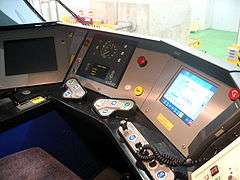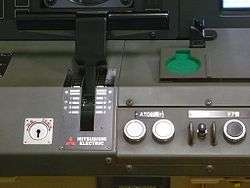Automatic train operation

Automatic train operation (ATO) is an operational safety enhancement device used to help automate operations of trains. Mainly, it is used on automated guideway transits and rapid transit systems which are easier to ensure safety of humans. Most systems elect to maintain a driver (train operator) to mitigate risks associated with failures or emergencies.
Many modern systems are linked with Automatic Train Control (ATC) and in many cases Automatic Train Protection (ATP) where normal signaller operations such as route setting and train regulation are carried out by the system. The ATO and ATC/ATP systems will work together to maintain a train within a defined tolerance of its timetable. The combined system will marginally adjust operating parameters such as the ratio of power to coast when moving and station dwell time, in order to bring a train back to the timetable slot defined for it.
Types of train automation

According to the International Association of Public Transport (UITP), there are five Grades of Automation (GoA) of trains:[1][2]
- GoA 0 is on-sight train operation, similar to a tram running in street traffic.
- GoA 1 is manual train operation where a train driver controls starting and stopping, operation of doors and handling of emergencies or sudden diversions.
- GoA 2 is semi-automatic train operation (STO) where starting and stopping is automated, but a driver operates the doors, drives the train if needed and handles emergencies. Many ATO systems are GoA 2.
- GoA 3 is driverless train operation (DTO) where starting and stopping are automated but a train attendant operates the doors and drives the train in case of emergencies.
- GoA 4 is unattended train operation (UTO) where starting and stopping, operation of doors and handling of emergencies are fully automated without any on-train staff.
Notable examples
- On the New York City Subway, the BMT Canarsie Line (L train) began full ATO in June 2012.[3][4] IRT Flushing Line (7 <7> trains) are undergoing track and signal modernization, with completion in 2016.[5]
- On the London Underground, the Central, Northern, Jubilee, and Victoria lines run with ATO.
- On the Nuremberg U-Bahn, existing U2 and new U3 lines converted to ATO, with one-year mix service.[6]
- On the Barcelona Metro, the L9 (as the Europe's longest driverless line), L10 and L11 runs with ATO.
- The Rio Tinto Group has iron ore railway driverless go-ahead.[7][8]
- The Tren Urbano, which serves the San Juan metropolitan area, has an Siemens ATC system that allows for fully automatic operation.[9]
- The Vancouver SkyTrain in Vancouver, British Columbia, is an automated and driverless system commissioned in 1985.
- On the Milan Metro, the M1 Red Line runs with ATO.[10]
- On the Mass Rapid Transit (Singapore), all lines operating currently run with ATO since 1987.
Future
Many railways are planning on using ATO. The Delhi Metro officials have stated that driverless trains with advanced features will run on the Botanical Garden - Kalkaji corridor with trial runs planned for the last week of July 2016 and the trains being operated on the route from August 2016 onwards. Initially, drivers will be deputed to operate the trains but they will be gradually withdrawn said a metro official.[11] ATO was introduced on the London Underground's Northern line in 2013 and will be introduced on the Circle, District, Hammersmith & City, and Metropolitan lines by 2022. Although ATO will be used on Crossrail and Thameslink, it has not yet been implemented on UK mainline railways. The Toronto Subway and RT is undergoing signal upgrades in order to switch to have the system running on ATO over the next decade.[12] The U-Bahn in Vienna gets an ATO in 2023 on the new U5 line.
See also
- List of automated urban metro subway systems
- Autonomous car
- Communications-based train control – A moving block signalling system that can be used to automate operation of trains
- Guided bus
- List of driverless trains
- One-man operation – A method of train operation on train systems of grade GoA 2
- Automation of the London Underground
References
- ↑ International Association of Public Transport. "A global bid for automation: UITP Observatory of Automated Metros confirms sustained growth rates for the coming years" (PDF). Belgium.
- ↑ Elisabeth Fischer (23 August 2011). "Justifying automation". Railway-Technology.com.
- ↑ New York City Transit - History and Chronology Archived October 19, 2002, at the Wayback Machine..
- ↑ "MTA L Train Response to Squadron" (PDF) (Press release). Metropolitan Transportation Authority. 2011-09-06. Retrieved 2011-10-29.
- ↑ "New York Flushing Line CBTC contract awarded". Railway Gazette. 2010-06-28. Retrieved 2011-10-29.
- ↑ "Driverless operations start in Nürnberg". Railway Gazette International. Archived from the original on 2009-07-01.
- ↑ Railway Gazette International July 2008 p203
- ↑ http://www.mineprocessing.com/News/detail-a135-b2-c0-d0-e0-f.html
- ↑ www.railway-technology.com Tren Urbano Rapid Transit System, Puerto Rico - Accessed 2011-07-12
- ↑ http://www.atm.it/it/AtmNews/Comunicati/Pagine/LineaM1,nuovosistemadiregolazionedellacircolazione.aspx
- ↑ Rajput, Abhinav (April 28, 2016). "South Delhi-Noida direct Metro connectivity by August". HT Media Limited. Hindustan Times. Retrieved 10 May 2016.
- ↑ Wheeler, Charles (2008-12-17). "Yonge Subway Extension – Recommended Concept/Project Issues" (PDF). TTC.